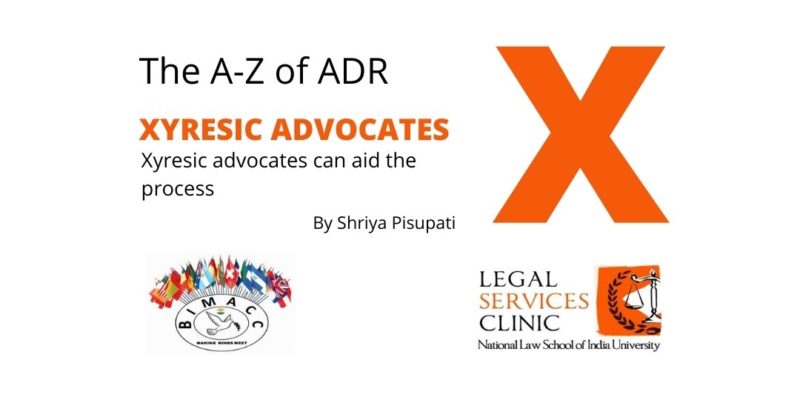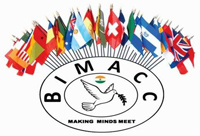
A-Z of ADR: XYRESIC ADVOCATES CAN AID THE PROCESS
-Shriya Pisupati (IInd Year, NLSIU Bangalore)
What does it mean to be a xyresic advocate?
A xyresic advocate is one who has a sharp mind. Dispute resolutions often call for situations that require one to quickly come up with solutions to problems that arise. An advocate who can think clearly and meet the requirements of the situation called for is key to an effective dispute resolution process.
Role of advocates in a Court Room v. advocates in Alternate Dispute Resolution:
The skills and techniques required by an advocate in a Courtroom are very different from that required by an advocate participating in the dispute resolution process. To participate effectively in the dispute resolution process an advocate must change their role from an adversarial stance to that of cooperation and conciliation.[1] Arguing in Court may require an advocate to put across their arguments aggressively and with conviction to convince the court of the merit in their argument. However, when it comes to dispute resolution, lawyers require a modified skill set. They will need to shift gears and adopt different strategies. It is important that an advocate actively listens, is patient, flexible and empathetic towards the other side.[2]
Role of an Advocate in the Mediation Process:
The role of an advocate in the mediation process is primarily advisory in nature. It can be looked at in detail across the three phases of mediation:
Pre-mediation: Prior to the mediation process, advocates can help their clients by discussing what the process of mediation is and how it is conducted. They should also clarify that the client is usually the one making decisions. The advocate must inform the client of the opportunity to have private discussions with either the mediator or the advocate and client. The advocate along with the client must determine beforehand the range of acceptable outcomes and their legality. The advocate and client must also discuss the costs, time and risks of litigation.
During Mediation: The role of the advocate during the process of mediation is primarily to offer guidance and advice to their client. The advocate helps maintain a supportive and cooperative environment. They help the client balance the benefits and risks involved in a proposal and assess their legality. They give direction to the discussions. The role of the advocate is to look out for their client’s interest during the process.
Post-Mediation: If the mediation is successful then the advocate prepares the agreement that was settled upon by the client. The advocate must also uphold the spirit of the settlement and cooperate with the court in execution of the order passed. However, if the mediation is not successful, the advocate must assist the client in proceeding with litigation or another alternate dispute resolution mechanism.
Role of an Advocate in Arbitration:
The arbitration process is less formal than a court process, however, parties still provide testimony and give evidence much like in a trial. In the preliminary meeting, the advocate demonstrates a willingness to cooperate with the opposing counsel. The advocate also prepares the arbitrator on the facts and issues of the case and prepares the pleadings. Post- hearings, the advocate makes it easy for the arbitrator to prepare the award. The advocate also interprets the award to the client.
It
is therefore necessary to recognize that the role of the advocate in a
Courtroom and in alternative dispute resolution is functionally different. This
distinction is emphasized by Justice Nagappan of the Madras High Court when he
says that advocates should change their attitudes from winning at any cost to
taking a reasonable approach to assist the parties to reach an amicable
settlement. Advocates, therefore, play a vital role and can influence the
process and outcome of the dispute resolution. Having such an important role,
effective dispute resolution can take place only when the advocate is capable
of thinking quickly and clearly.
[1]Kathy Douglas and Becky Batagol, ‘The Role of Lawyers in Mediation: Insights from Mediators at Victoria’s Civil and Administrative Tribunal’ Monash University Law Review 40(3) <http://www.austlii.edu.au/au/journals/MonashULawRw/2014/30.pdf> accessed 6 August 2020
[2] Michael Lang, ‘From Advocate to Advisor: The Role of the Lawyer in Mediation’ <https://www.mediate.com/articles/langlawyerrole.cfm> accessed 6 August 2020
-Shriya Pisupati (IInd Year, NLSIU Bangalore)
Shriya Pisupatiis a Second Year Law Student at the National Law School of India University (NLSIU), Bangalore.
BIMACC expresses its gratitude towards the author and to the members of the Legal Services Clinic, National Law School of India University (NLSIU) for their support in our collaborative efforts to promote ADR with this series titled “A-Z of ADR”. The purpose of this series is to increase the understanding of certain fundamental concepts of Alternative Dispute Resolution.
The Legal Services Clinic is a student-run committee that provides free legal services to the socially and the economically backward sections of the society who have difficulty accessing the judicial system. It also has a mandate of spreading legal awareness and providing free legal assistance to those who cannot afford it.
Website: www.legalservicesclinic.org/
Facebook: @legalservicesclinic
Email: lsc.nlsiu@gmail.com
Phone Number: 073586 73214
Disclaimer: The views and opinions expressed in this blog are those of the author and do not necessarily reflect the official policy or position of BIMACC, any of the members of the Board, or the empanelled neutrals.
